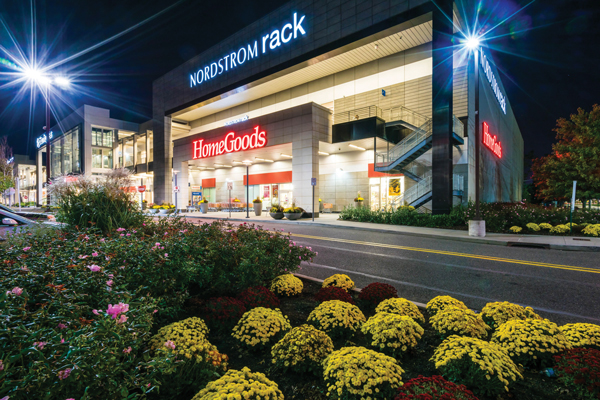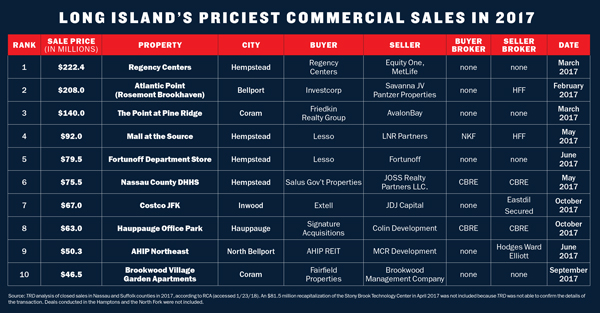Trending
Money Moves: biggest buys of the year
TRD’s ranking of priciest commercial sales found investor appetite for all types of Long Island assets

Everybody seems to want in when it comes to Long Island commercial real estate. Due to the dense population, low vacancy rates and high demand in the area, investors are enthusiastic about deals on the Island — so much so that brokers claim there aren’t enough opportunities to satisfy the demand.
Because of Long Island’s notoriously difficult approval processes, new builds are slow to come to fruition and the existing commercial space in many areas is already leased up and built out. Large swaths of office or industrial space are rarely available. That means creativity, speed and lots of local knowledge are crucial for Long Island agents as they try to meet clients’ needs. They’ve also had to adapt to the reality of “live, work, play” developments, which, with their continuing popularity, go against the office and industrial park model they’d long been used to.
“Everyone is adjusting to where the market is,” said Martin Lomazow, a senior vice president at CBRE’s Long Island operation. These days, people are looking for housing, retail and office space that’s clustered together, he said, as opposed
to each being compartmentalized, as it has been in the past.
Another big shift has occurred in the industrial market, where space is scarce and prices are sky-high. That sector is booming, agents said, as companies move east from the boroughs of New York City and companies like Amazon seek more distribution centers. Many brokers said the demand and the rental rates are the highest they’ve seen in their careers.
 The right retail
The right retail
For all the doomsday predictions for retail, there’s still opportunity for investors in Long Island, brokers said.
“Every single sector is going through a major shift, but retail is the most confusing,” said David Pennetta, the executive director and managing
broker of Cushman & Wakefield’s Long Island office. Reports of store closings have dominated the news, and although local retail rents are down slightly from last year, retail properties were still hot commodities among investors looking to buy on the Island. And as multifamily developments finally get the go-ahead in Long Island, attention is on downtowns again.
The average rental rate for retail space for Suffolk and Nassau counties combined was about $26 per square foot as of the fourth quarter of 2017, according to data from American Investment Properties. That’s about the same rate as at the end of 2016. The vacancy rate at the end of the fourth quarter was 4.6 percent, up from 3.7 percent in 2016.
Strip malls have been hurt the most by retail’s changing fortunes, said Pennetta, who added that he believes those properties need “to be reinvented.” And because of the increased interest in walkability from both residents and area workers, developers are looking to combine entertainment, dining and staples like grocery stores back into the village centers.
Grocery-anchored shopping centers are a good bet for investors, especially if they already have good tenants and are in a good location, said Jose Cruz, a senior managing director at HFF. But strip malls can also be a good investment, for the right company, he added.
Indeed, The Real Deal’s ranking of 2017’s top 10 commercial deals as recorded by Real Capital Analytics (RCA) found that the priciest was Regency Centers Corporation’s $222.4 million purchase of two shopping centers in Nassau County. That includes the 312,381-square-foot Gallery at Westbury Plaza — a mall containing stores such as Nordstrom Rack and Old Navy — and the 394,451-square-foot Westbury Plaza, a strip mall that currently houses a Walmart and a Costco. The deal was part of Regency’s March merger with Equity One.
The next-biggest retail deal, no. 4 on the list, was the sale of the Mall at the Source in Westbury, which was largely vacant. Its owners defaulted on its loans when it was purchased in May for $92 million. HFF represented the sellers, a subsidiary of Starwood Property Trust and a REMIC trust managed by C-III Asset Management. The adjacent Fortunoff Department Store was the fifth-biggest deal, selling for $79.5 million. Both properties were purchased by China Lesso Group Holdings, which was represented by Newmark Knight Frank.
Despite all the talk about retail’s demise, Cruz said there was a good deal of interest in the mall from REITs, large institutional retail owners and local developers. Many potential investors saw it as a chance to get a good price for the property, he added.
“In the end, a foreign capital source was most aggressive on pricing and terms. The location and demographics were a major driver for this transaction,” Cruz said in a statement at the time.
Lesso Home is planning a $25 million renovation of about half of the 512,528-square-foot mall. The company, based in Hong Kong, plans to showcase a range of its home furnishings and decor “all under one roof,” said company representative Michael Mai at an event at the mall in October. It is set to open in the summer of 2018, Mai said, adding that dining and entertainment will fill out the rest of the mall.
Multifamily deals
Since new builds are generally slow going on Long Island, existing housing remains a solid investment, with an ever-growing number of investors bidding on the properties.
Multifamily developments are one of “the most-sought-after product types for investors,” Lomazow said. Although oversaturation of the market is a worry in some parts of the tristate area, Long Island’s long development process means there is still not enough multifamily product to meet demand.
Number two on the ranking of priciest deals was the $208 million sale of Atlantic Point — now branded as Rosemont Brookhaven — a 115-acre, 798-unit apartment complex in Bellport. The seller’s broker, HFF, claims it was one of the priciest apartment sales in Long Island’s history, and added that the listing had double the number of bids the agents were expecting. “We’d usually get three to five bids,” said Cruz, who worked on the deal in February. “We had well over 10 for this one.”
The seller was a joint venture between Pantzer Properties and Savanna, a real estate investment manager based in New York City. Investcorp, a Bahrain-based investment company, was the buyer. Rosemont Brookhaven is made up of 137 two-story buildings that contain one-, two-, and three-bedroom residences, according to HFF.
Another apartment complex, the Point at Pine Ridge, formerly known as Avalon Pines, ranked third on TRD’s list. San Francisco-based Friedkin Realty Group bought the 450-unit complex from the real estate investment trust AvalonBay Communities for $140 million, or about $311,000 a unit, in an off-market deal. Friedkin has been looking to the East Coast to expand, according to Melissa Quigg, vice president of acquisitions and asset management at the company. This was their first foray into Long Island real estate, but the company also made purchases in other parts of the state, as well as in New Jersey and Connecticut.
Work space woes
Clients looking for a large block of Class A office space on Long Island are in for a challenge, agents said. It’s all but impossible to find 100,000 square feet of it, much less in the new buildings that companies are seeking. “It’s just getting tighter and tighter,” Lomazow said.
Average asking rates for Class A office space rose from $30.62 in the fourth quarter of 2016 to $31.16 per square foot in the fourth quarter of 2017, while Class B increased from $23.94 to $24.59 per square foot over the same period, according to CBRE’s Long Island office report. That’s up 2 percent from the same time in 2016.

Local knowledge of the office product in the area is now more important than ever, Lomazow said. Brokers need to keep an eye on properties and be ready to jump on them if/when they become available. That means being out in the communities and not waiting for an opportunity to show up on a service like CoStar.
Agents also often have to be creative when they are tasked with finding large spaces, Lomazow said. That translates to assembling space from several buildings for one client or making deals on space that has never been on the market.
Pennetta also sees clients going further and further east to find space, and that properties that were formerly “too far out” for investors in the past are now being reconsidered.
“Red hot” industrial
Like other sectors, industrial space is scarce. And there hasn’t been much construction of either industrial or office buildings in the past several decades, Pennetta said.
“For industrial above 30 feet (ceiling height), there’s a 3 percent vacancy,” Pennetta said.
And the prices are going up, too, he said, with warehouse space fetching record sales rates of up to $250 or $275 a square foot. It used to be more like $80 a square foot, he said. Rental tenants might pay up to $17 per square foot, up from about $9 a few years ago, Pennetta added.
Part of the interest is coming from companies that have migrated from Queens and Brooklyn, where residential towers are taking over former industrial areas. Plus, e-commerce sites like Amazon need more space for distribution centers to serve their Long Island customers. There’s been enough interest in industrial space that some office buildings have converted to industrial to serve the market, according to Lomazow.
That’s what happened at the former headquarters of Arrow Electronics, a 164,000-square-foot office in Melville. Stellae International, a logistics firm for the fashion industry, bought the property for $14.7 million in 2016. Stellae stripped the existing space “down to the steel,” Lomazow said, to create space for storage, shipping and other industrial needs.
Lincoln Equities Group hopes to tap into the need for industrial space with an almost 200,000-square-foot warehouse and distribution facility in Hicksville. Set to break ground in the third quarter of 2018, it will be the first speculative industrial building on Long Island in five years, according to JLL Executive Vice President Thomas DiMicelli, who will head up leasing efforts along with JLL International Director Rob Kossar and JLL Managing Director Leslie Lanne. They have been talking to potential tenants but have not yet finalized any deals.
The new facility will have up to 30 loading docks, 32- to 50-foot-tall ceilings and state-of-the-art safety systems. Plus, Hicksville has direct access to the Long Island Railroad. Winters Bros. Hicksville currently owns the 9-acre property, and Lincoln Equities plans to close on its purchase in 2018, DiMicelli said.
“Our new facility will be optimal space for warehouse and distribution users, including logistics companies and e-commerce-based ‘last-mile’ delivery companies that require superior loading,” Joel Bergstein, president of Lincoln Equities, said in a statement in December.
The demand for “red-hot” industrial space gets investors’ attention, but there are other benefits, Cruz said.
“Industrial space takes little maintenance,” Cruz continued. “It doesn’t need much work and typically has long leases. You don’t have to rebuild them every five years.”
But, as with office, it’s crucial to stay on top of the market, work fast and be inventive when spaces become available, even if they aren’t perfect.
“The push is on,” Cruz said. “Sometimes it takes a lot of smaller deals to get to scale, so you gotta chase those deals when they come up.”
Cruz said he thinks the investment community will continue to be interested in properties in all sectors on Long Island in 2018. “You can’t say that about every market,” he said.
Garden City and Mineola are two of Cruz’s favorite areas. “It’s easy to convince investors to invest there,” he said, adding that Hempstead is another area “on the way up.”





